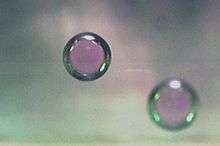Antibubble


An antibubble is a droplet of liquid surrounded by a thin film of gas, as opposed to a gas bubble, which is a sphere of gas surrounded by a liquid. Antibubbles are formed when liquid drops or flows turbulently into the same or another liquid. They can either skim across the surface of a liquid such as water, in which case they are also called water globules, or they can be completely submerged into the liquid to which they are directed.
Differences between air bubbles and antibubbles
The behavior of antibubbles differs from that of air bubbles in three primary ways, and provides a ready means of identification:
- Antibubbles are held in place by surface tension, and move rapidly across the surface of the water. They can also be seen to ricochet off other objects in the water (such as air bubbles) and off the sides of a container in a manner similar to that of billiard balls.
- Under ordinary circumstances, antibubbles are short-lived. An air bubble with a soap skin may last several minutes. Antibubbles often have lifetimes of a few seconds or less; however, if the electrical potential between the inner and outer fluid is equalized, antibubbles can last as long as, or longer than, air bubbles. Recently, antibubbles with a lifetime of at least tens of hours were produced by adsorbing colloidal particles at the air-water interfaces of the antibubble.
- Antibubbles refract light in a different manner than air bubbles. Because they are water droplets, light entering them is refracted back toward its source in the same manner as rainbows are produced. Because of this refraction, antibubbles have a bright appearance.
Potential uses for antibubbles
If antibubbles can be stabilized they can be used to form a long lasting froth — antifoam. Possible uses for antifoam are as a lubricant or using the thin passageways permeating antifoam as a filter for air or other gasses.
Antibubbles themselves could be used for chemical processes such as removing pollutants from a smokestack. Replacing the air in antibubble shells with another liquid could be used for a drug delivery system by creating a shell of liquid-polymer around a drug. Hardening the polymer with ultraviolet light would create a drug filled capsule.
Lifetime
The lifetime of surface antibubbles can be prolonged indefinitely by making the water under them vibrate.[1][2] These are called "walking bubbles" and are used as a model of quantum mechanical behavior.[3]
References
- Dorbolo S, Caps H, Vandewalle N (2003). "Fluid instabilities in the birth and death of antibubbles". New Journal of Physics. 5 (Dec. 22): 161. Bibcode:2003NJPh....5..161D. doi:10.1088/1367-2630/5/1/161.
- Het Panhuis M, Hutzler S, Weaire D, Phelan R (1998). "New variations on the soap film experiments of Plateau I: Experiments under forced drainage". Philosophical Magazine B. 78 (July 1): 1–12. Bibcode:1998PMagB..78....1P. doi:10.1080/014186398258320.
- Kim PG, Stone HA (2008). "Dynamics of the formation of antibubbles". Europhysics Letters. 83 (5): 54001. Bibcode:2008EL.....8354001K. doi:10.1209/0295-5075/83/54001.
- Postema M, de Jong N, Schmitz G, van Wamel A (2005). "Creating antibubbles with ultrasound". Proc IEEE Ultrason Symp: 977–980.
- Tufaile A, Sartotelli JC (2002). "Bubble and spherical air shell formation dynamics". Physical Review E. 66 (November): 056204. Bibcode:2002PhRvE..66e6204T. doi:10.1103/PhysRevE.66.056204.
- Weiss P (May 15, 2004). "The rise of antibubbles". Science News. 165 (20): 311–312. doi:10.2307/4015222. JSTOR 4015222.
- Poortinga A (January 20, 2011). "Long-lived antibubbles: stable antibubbles through Pickering stabilization". Langmuir. 27: 2138–2141. doi:10.1021/la1048419.
- Stong CL (April 1974). "The amateur scientist: Curious bubbles in which a gas encloses a liquid instead of the other way around.". Scientific American. 230 (4): 116–120.